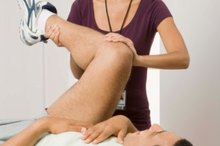A Torn Ligament in a Thumb
A torn ligament in the thumb usually affects the ulnar collateral ligament, which is used to pinch and grasp 34. The ulnar collateral ligament also stabilizes the thumb so it doesn’t bend too far 34. An ulnar collateral ligament tear is often called a skier’s thumb or a gamekeeper’s thumb; skier’s thumb describes an acute injury and gamekeeper’s thumb a chronic injury, but the terms are often used interchangeably 34.
Cause
Ulnar collateral ligament injuries are usually the result of a sudden force, called a valgus force, bending the thumb backwards, away from the hand 34. The sudden force on the thumb tears the ligament either partially or completely 3. An acute injury such as a fall on the outstretched thumb or a repetitive motion injury from overuse can tear the ligament.
Symptoms
Signs of a Torn Ligament in the Finger
Learn More
Pain occurs at the time of the injury. Afterward, the thumb is unstable; it’s difficult to grasp objects tightly between the thumb and index finger. Bruising and swelling may develop at the base of the thumb. If the ligament has completely torn away from one of the bones, the end may fold under and form a bump that can be felt at the base of the thumb. This bump is called a Stener lesion.
- Pain occurs at the time of the injury.
- If the ligament has completely torn away from one of the bones, the end may fold under and form a bump that can be felt at the base of the thumb.
Diagnosis
Your doctor may assess the degree of injury by stress testing, which involves bending the thumb and measuring how far it can be moved away from the hand, compared to the uninjured thumb. Ability to move the thumb less than 30 degrees, or 15 degrees more than the uninjured thumb, indicates a partial tear. If the thumb can move more than 30 degrees from the hand or more than 15 degrees than the uninjured thumb, diagnosis is likely to be a complete tear. X-rays are done to check for fractures; sometimes a small piece of bone is pulled away from the thumb at the time of injury. This type of injury is called an avulsion fracture.
- Your doctor may assess the degree of injury by stress testing, which involves bending the thumb and measuring how far it can be moved away from the hand, compared to the uninjured thumb.
Treatment
Rehabilitation Exercises for a Dislocated Finger
Learn More
If the ligament isn’t completely torn, a cast may be used for around six weeks to stabilize the joint and allow the ligament to heal. Ice packs help decrease pain and swelling. If the ligament is completely torn, surgery to repair the ligament is necessary. A cast is normally worn for six to eight weeks after surgery to repair a torn ligament in the thumb.
- If the ligament isn’t completely torn, a cast may be used for around six weeks to stabilize the joint and allow the ligament to heal.
- A cast is normally worn for six to eight weeks after surgery to repair a torn ligament in the thumb.
Considerations
Even with surgery, complications can occur. Nerves in the thumb can be damaged, resulting in numbness. Stiffness, tenderness and discomfort persist after surgery, but are usually reversible with physical therapy and usually subside within a year.
- Even with surgery, complications can occur.
- Stiffness, tenderness and discomfort persist after surgery, but are usually reversible with physical therapy and usually subside within a year.
Related Articles
References
- American Academy of Orthopedic Surgeons: Sprained Thumb
- Wheeless' Textbook of Orthopedics: Gamekeeper's Thumb
- Orthogate: Ulnar Collateral Ligament Injuries of the Thumb
- Joint Pain Info: Ulnar Collateral Ligament Tears
- Hung CY, Varacallo M, Chang KV. Gamekeepers Thumb (Skiers, Ulnar Collateral Ligament Tear). In: StatPearls. Treasure Island (FL): StatPearls Publishing; 2019 Jan-.
- Tsiouri C, Hayton MJ, Baratz M. Injury to the ulnar collateral ligament of the thumb. Hand (N Y). 2009;4(1):12-8. doi:10.1007/s11552-008-9145-8
- Tang P. "Collateral ligament injuries of the thumb metacarpophalangeal jointJ Am Acad Orthop Surg. 2011 May;19(5):287-96.
Writer Bio
A registered nurse with more than 25 years of experience in oncology, labor/delivery, neonatal intensive care, infertility and ophthalmology, Sharon Perkins has also coauthored and edited numerous health books for the Wiley "Dummies" series. Perkins also has extensive experience working in home health with medically fragile pediatric patients.









